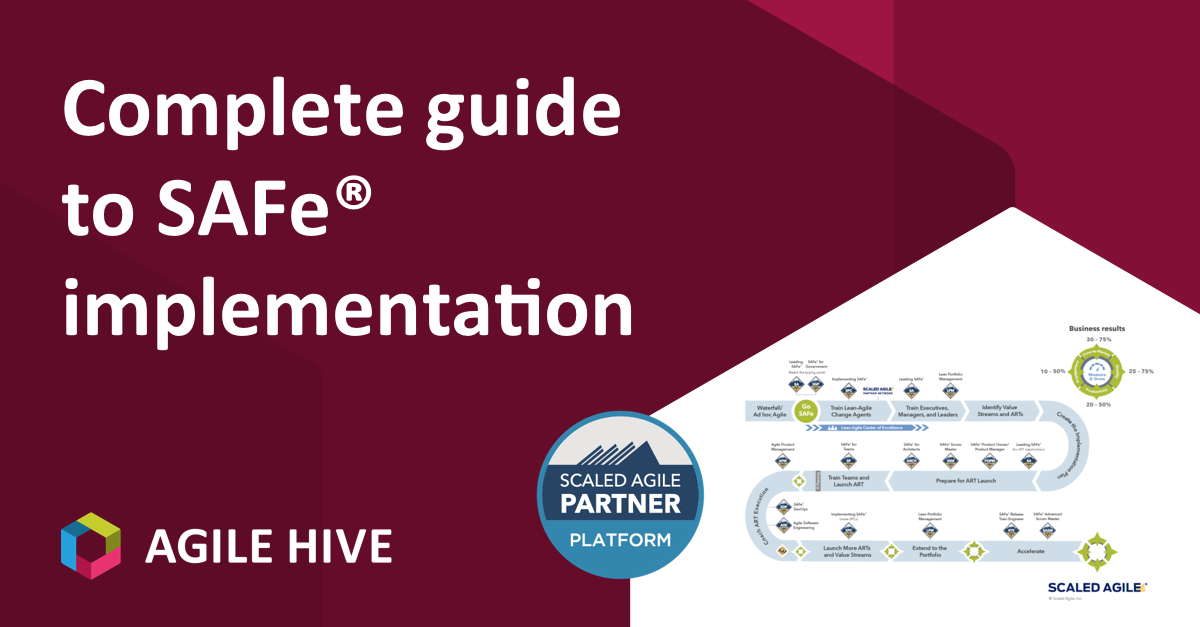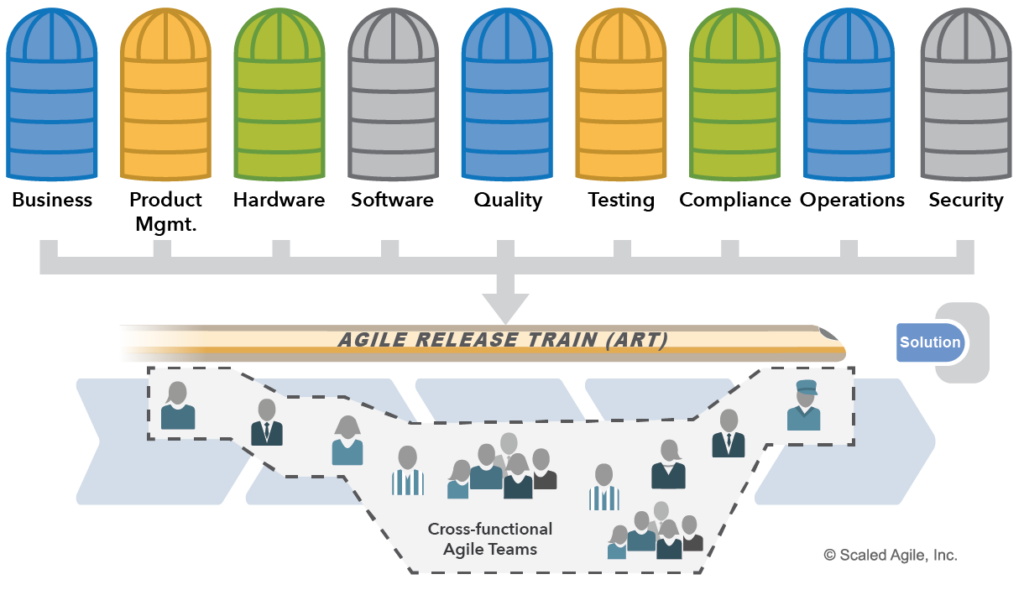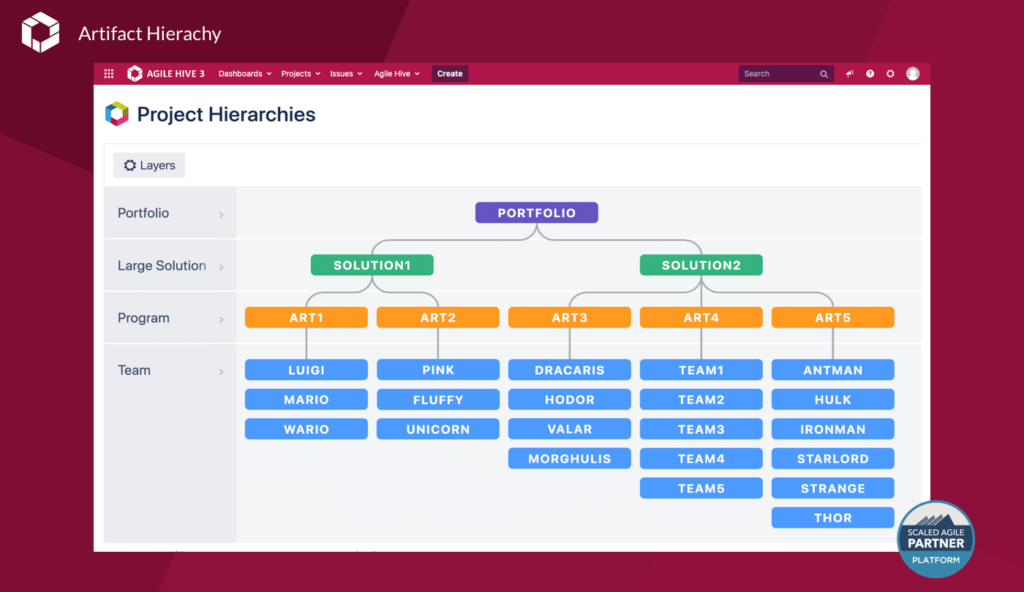How should you approach a SAFe implementation as a company? Who should be on the team?
The software engineering industry is continuing to grow exponentially. To stay innovative, experts and teams need to collaborate. The introduction of a methodology to handle projects and tackling tasks brought stability and direction in the industry. This is the Agile effect.
Agile methods, practices, and principles have re-framed how the software engineering industry operates with its meticulously efficient iterative process. To further implement the Agile system effectively, the scaled agile framework, SAFe, was coined for large-scaled projects. The scaled agile framework enabled enterprises to effectively take on projects and simplify software development for enterprises.
SAFe is defined as an array of organization and workflow patterns utilized for implementing agile practices at the enterprise level. It is the framework that promotes the proper orientation, alliance, and delivery across agile teams.
To dive more into SAFe and its implementation intricacies, let’s consider the steps you should take as a company to implement SAFe and the key players that you should include in your team.
What is the Scaled Agile Framework (SAFe)?
The Scaled Agile Framework was developed by Dean Leffingwell, who combined lean and agile principles to create a methodology to handle large-scale enterprise-level software projects and recently instill business agility into the whole organization. SAFe is a result of Dean’s systematic combination of two popular project management theories to reduce waste and increase teams' responsiveness.
Together, it provides a prescriptive way of carrying out projects. The scaled agile framework is proven to be efficient in its use and results. It is the ideal system for carrying out large-scale projects because it applies lightweight experience while looking ahead for the different layers of complexity that one project may imply.
The implementation of SAFe transpires on three levels. These three levels include the Team level, Program level, and the Portfolio level. In each one of these layers, there are key players involved who play distinct key roles.
Team Level
At the team level, scrum processes are applied, and the typical agile team structure is used. The key players involved are the scrum master, the product owner, and a team to support and deliver the project.
An agile team is a group of members who have the necessary skills to draw stories defined by the product owner from the backlog and elaborate on them to design, build, test, and deploy solution value elements. The team performs work in small batches, called iterations. At each delivery, the results are assessed, tested, and iterated to correct any issues.
Source: https://www.scaledagileframework.com/agile-teams/
The scrum master is the coach vital to guide the Agile team. Its responsibility is to teach and tutor the team on Scrum and any other framework required to make the Agile process successful.
Finally, the product owner stands as the customer in the Agile process. Its responsibility is to prioritize the story and ensure that the value delivered by the team meets the end user’s needs.
Program Level
At the program level implementation, resources, teams, and stakeholders work towards a system development mission. An assortment of hands is actively in sync which each party responsible for some role to a valuable part of the solution. This team is often referred to as the Agile Release train. It lives by a common set of principles where they incrementally deliver value in iterations and at a fixed cadence.
The program level includes the combined efforts of the Product Manager, Release Train Engineer, System Team, System Architect, Shared Resources, DevOps, UX, Business Owners, Release Management. As said earlier, the product manager is the voice of the customer defining features and the needs of end-users to the team. The system team and architect will apply the systems thinking to define the system's overall architecture in development. They also map out the nonfunctional parts and make inferences on the major elements.
Source: https://www.scaledagileframework.com/agile-release-train/
The DevOps involves technical practices utilized in planning, developing, testing, deploying, and maintaining the system. UX builds the user experience interface of the system, while the Business owners are the stakeholders saddled with the responsibility of governing the project and its business value. The release train engineer is the chief scrum master at this level who guides the flow of value and ensures maximum optimization of the resources through the program using different mechanisms.
Portfolio Level
This comprises the principles, practices, and roles required to start, build, and manage systems and solutions in which the enterprise needs to meet its objectives and goals. Therefore, the portfolio level will constitute; the Program Portfolio, Management, Enterprise Architect, and Epic Owners.
Source: https://www.scaledagileframework.com/portfolio-safe/
Implementing the Scaled Agile Framework
SAFe implementation roadmap follows a step by step approach to developing a successful agile business system. While this implementation approach is intentionally prescriptive, it is vital that the techniques and methodology you apply fit your company's overall hierarchy and goals.
Source: https://www.scaledagileframework.com/implementation-roadmap/
This SAFe implementation roadmap recommends the following steps:
1. Identify the why
Any change management, particularly one that involves SAFe, can be a tedious process. While the outcome has been proven beneficial for many, it is also fair to recognize that SAFe may not be for everyone. This is why you need to define and identify the current flaws in your system. Understand upfront how a prescriptive and iterative approach can help your current ways. Ensure also that you have broader SMART goals tied to SAFe to track what you want to achieve at the end of this process.
2. Train your executives, managers, and leaders
On identifying the needs and the flaws in your previous ways, you now know the gaps that need to be filled and the teams that need to be involved. SAFe requires the whole team to be on board and aligned for this methodology to work. The most efficient path is to start from the top and train your leaders to be strong agents of SAFe. Train your team of executives and managers to become evangelists and enabler of the SAFe way. In doing so, you will also increase their ability and broaden the scope of solution providers.
3. Identify Value Streams and ARTs
There has to be an awareness of the organization’s broader purpose and an explicit understanding. Identifying the value streams and Agile Release Trains will require a new organizational model optimized to promote value in all functional areas and activities in the system. Building the value stream, identifying the trigger, and steps required to create value with maximized lead time is vital. Defining every component of your train will determine the strength of your work at the product level. ART is crucial to determine how productive and valuable the framework will yield.
4. Create the Implementation Plan
Upon identifying your value stream and ART, creating an implementation plan whereby the team, managers, and leaders can apply this training knowledge to build strategies is the next step. Creating a plan involves picking a target (usually the first value stream), narrowing the project's scope so that the newly trained team members can narrow their scope and focus on a specific target. Following this, analyze to define the development value stream, deliverable, and parameters necessary for this project. This analysis will help pick the first ART and create a preliminary plan for additional ARTs and value streams.
5. Prepare for ART Launch
After the plan and stakeholders have been defined, preparing the ART for launch is the next step. In contrast to the implementation plan, the ART launch defines the boundaries and context-specific to your team and project. Building an Agile Release Train canvas and timeline will enable every member to understand the parameters of work.
6. Train Teams and Launch the ART
Despite the training done previously, some team members may be still lag in training. For a complete understanding of their roles at the Agile framework level and their deliverable, many organizations choose to hold a specific team training session where the ART launch is introduced. This step aims to fully align the team into their roles and get every member ready for launch. The launch usually takes place following the completion of the first program increment planning event held.
7. Coach ART Execution
While the launch has been a success, a particularity of SAFe is continuous coaching and iterative learning opportunity. Inspecting the work being done in increments and adapting to the strengths of the ART with continual improvement is what is distinct from this framework. This step is not a step at all. It is the stream of events where knowledge becomes understanding, and all previous learning is put to practice. For organizations new to this methodology, we will often recommend having specialized coaches at the beginning supporting these processes.
8. Launch More ARTs and Value Streams
Once the first ART is in action, it is time to truly put all the values learned into launching more ARTs. The success of one will pave the way for the success of the more. Launching more ARTs and value stream will translate into a bigger return for the enterprise. This is where the lean, iterative process is applied.
9. Extend to the Portfolio
With an implemented SAFe system, the team is in full force, meeting value, deliverable in increments, and at the right time. The next step is to extend this implementation into enterprise portfolio management.
10. Accelerate
The tenth and final step in the SAFe implementation in an enterprise is to accelerate. Here, the Agile system and Lean principles are the norms. Hence, it is left to the entire model to leverage the learning and successes, measuring the performance, and apply the learning to the entire enterprise.
Choose a good SAFe Software
While following the given implementation roadmap is essential. Choosing the right software solution to visualize the different processes is crucial to a good start into your SAFe journey.
There are a few software tools for SAFe on the market, but we prefer to use Agile Hive. It plugs straight into your existing Jira workspace, allowing you to:
- Automated reports for all SAFe levels
- All new PI Planning with Program & Breakout Boards
- Create new Teams, ARTs, Solutions, or Portfolios in seconds - configuration & boards provided out of the box
- Accurate SAFe® artifact hierarchy & transparency in every issue
- Dynamic navigation menu based on your enterprise levels
- Calculated fields for the WSJF
Want to try SAFe in Jira? Sign up for our free 30-day trial to see the benefits for you and your team.
Bottom Line
SAFe is a prescriptive guideline to help organizations apply lean and agile practices. With accelerated innovation and speed delivery becoming the norm, it is imperative to find sustainable ways for the team to collaborate and scale.
While Agile principles have long been utilized by small teams and the startup world, SAFe opens the doors for broader sized teams to take advantage of the same principles. With the right preparation and the right software tools, SAFe implementation becomes a hassle-free experience.
Further Reading
Agile Hive Implementation Project
Scaled Agile: SAFe 5.0 changes and how Agile Hive maps them
SAFe with Atlassian tools: Agile Hive is a Scaled Agile Platform Partner








